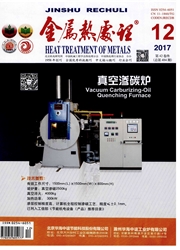

 中文摘要:
中文摘要:
在1700℃空气中对MoSi2发热元件的高温失效行为进行了研究,用XRD和SEM分析了发热元件使用前后的物相构成、组织结构和断口特征。结果表明,在1700℃失效发热元件表面及内部布满大量空隙和裂纹,Mo5Si3含量有所增加,元件表面保护膜呈熔融态,发热体内部有气体产生并形成气泡,气泡破裂后元件表面失去保护膜。断口出现宽度达0.2~0.3mm的裂缝,晶粒从1~2μm长大为7~8μm。因此认为这种发热元件不适合在1700℃以上使用。
 英文摘要:
英文摘要:
High-temperature failure behavior of MoSi2 heating elements was investigated at 1700℃ in air condition and its phase composition, microstructures and fracture surface were tested by XRD and SEM with EDS. The results indicate that there are many pores and cracks in the interior and on the surface of failure heating element and the content of MosSi3 is enhanced. The melting glass scale is observed on the surface of heating element. The scale is present in the form of bubbles, produced by the gases at that temperature. The scale is found to lose protective role as the bubbles are broken. The crack with 0.2 -0. 3 mm breadth appeares in the failure section and the grains grow from 1 -2μm to 7 8μm. Therefore, this kind of MoSi2 heating elements should not be applied above 1700℃.
 同期刊论文项目
同期刊论文项目
 同项目期刊论文
同项目期刊论文
 Evolution of Microstructure and Dimension of As-molded Parts during Thermal Removal Process of Wax-b
Evolution of Microstructure and Dimension of As-molded Parts during Thermal Removal Process of Wax-b Effects of Milling and Active Surfactants on Rheological Behavior of Powder Injection Molding Feedst
Effects of Milling and Active Surfactants on Rheological Behavior of Powder Injection Molding Feedst Thermal stability, grain growth and structure changes of mechanically alloyed W–Ni–Fe composite duri
Thermal stability, grain growth and structure changes of mechanically alloyed W–Ni–Fe composite duri 期刊信息
期刊信息
